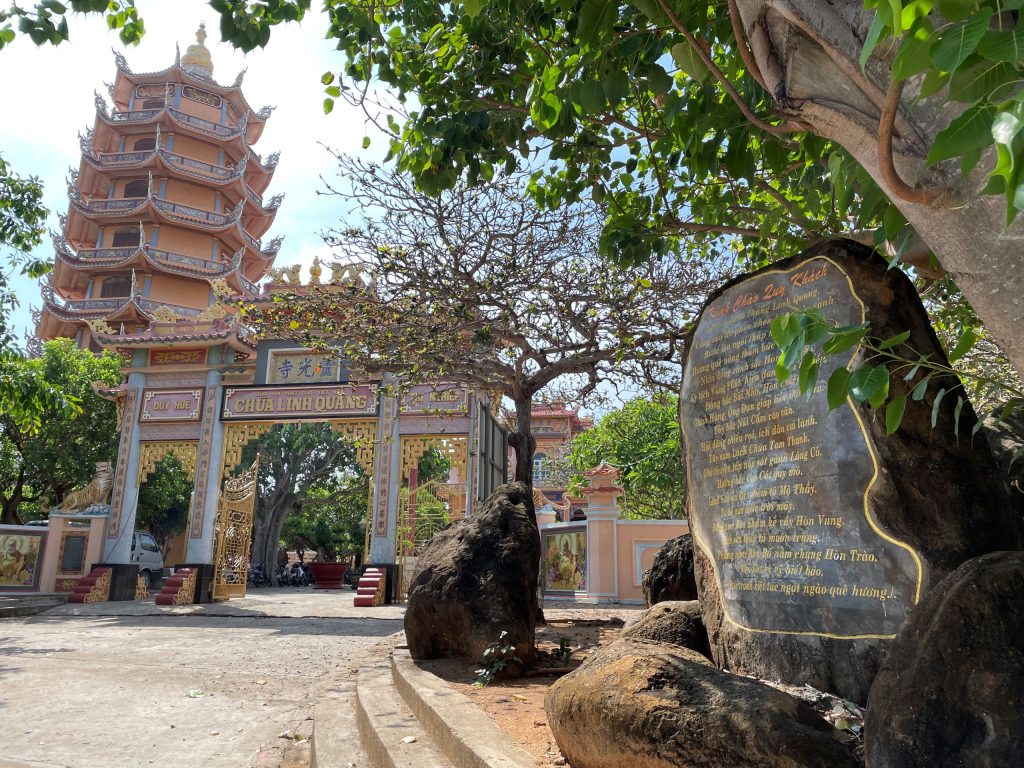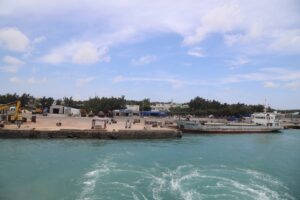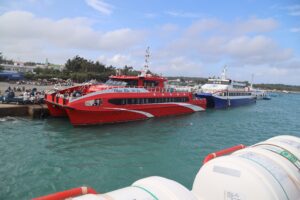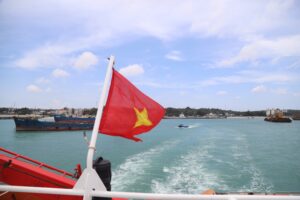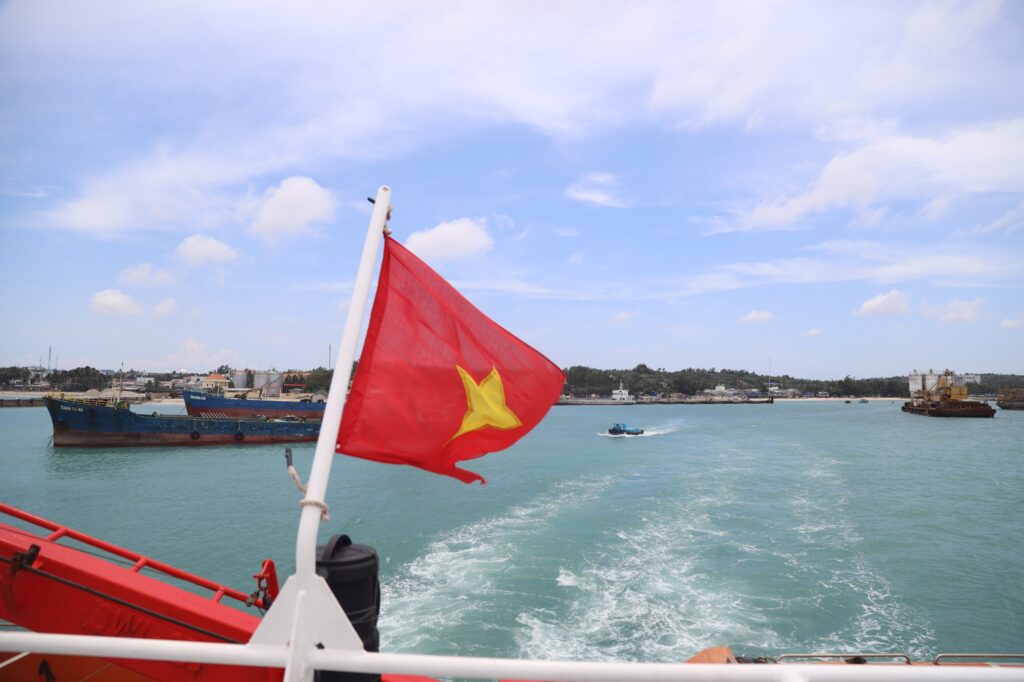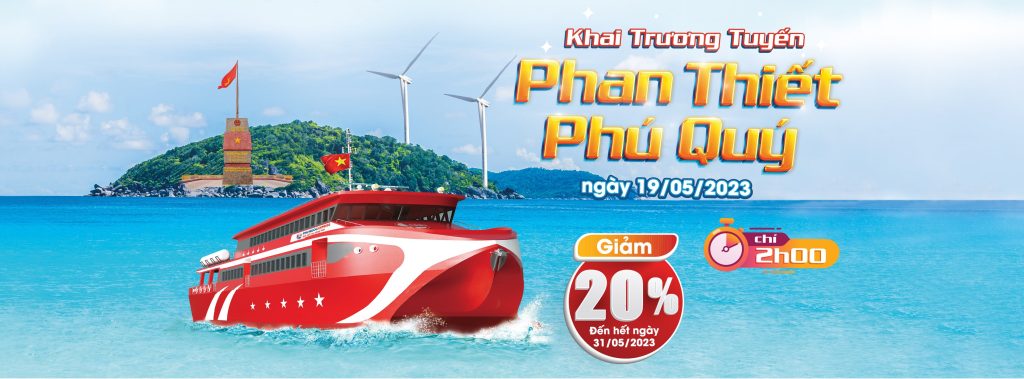For generations, the small island nestled in the vast ocean has harbored cultural and historical mysteries waiting to be uncovered and decoded. This place is not only blessed by nature with a feng shui formation of “dragon crouching, tiger resting,” resembling a sacred turtle—one of the four divine creatures (Dragon, Unicorn, Turtle, Phoenix)—but is also a land of refuge for those facing hardship. According to legend, this cultural land once bore the footprints of a renowned emperor in Vietnam’s history—Emperor Gia Long.
An old tale recounts: “When Emperor Gia Long lost his kingdom and was pursued by the Tay Son insurgents, he fled to Mui Nai (in present-day Ninh Thuan). Blocked from escaping by land, he opted for the sea. At that time, a loyal general of Gia Long’s entourage offered to stay behind and devise a delaying tactic to hold back the Tay Son army, giving the emperor a chance to escape. While drifting across the sea, Gia Long spotted a strange island and ordered the boat to land.”
Upon landing, Gia Long stopped and stayed briefly at Linh Quang Pagoda. Here, the emperor instructed the abbot to change the direction of the main hall entrance (to align with geomantic principles) so that the Dharma would flourish. The pagoda’s orientation changed from facing the West to facing the Northwest.
Later, the emperor sailed to Hon Tranh Island. Unexpectedly, the loyal general who stayed behind was killed in battle, and his body washed ashore on Hon Tranh. To commemorate his devoted service, Gia Long ordered a shrine to be built on the island. To this day, traces of Emperor Gia Long remain on Hon Tranh Island, such as the Gia Long Well (believed to be the spot the emperor pointed out for locals to dig a freshwater well) and Tran Bac Shrine (dedicated to the admiral who sacrificed his life to save the emperor).
Here, we see a recurring motif often present in legends about Gia Long’s exile—a freshwater well. Similar stories exist, such as the Gia Long Well or his footprints on Phu Quoc Island (Kien Giang Province). In the book “The Legends of Phu Quoc”, it is written: “From An Thoi Town in Phu Quoc, walk about 2 kilometers along a coastal forest path, and you’ll see a small shrine beside a rugged rock, which locals call the King’s Throne. Legend says it was left by Nguyen Anh (Gia Long) when he sought refuge from the Tay Son forces. In desperation, he stomped the ground and pointed his sword into the earth, swearing and praying to the gods. Suddenly, fresh water sprang forth from where his sword struck, and it still flows today. The imprint of his foot remains on the stone. Since then, locals have called it the Gia Long Well or the Fairy Well.”
We believe this legend may be connected to the folk perception of a divinely ordained ruler and the symbolic act of discovering life-giving sources, like water. If so, this would reflect the people’s high regard for the Nguyen dynasty—an interpretation scholars have only recently begun to acknowledge.
To honor the sovereign who endured great hardships to found his dynasty—not as a traitor bringing foreign forces against his own people—and to commemorate the emperor’s visit to the island, the monks of Linh Quang Pagoda inscribed a poem on the temple terrace:
“When the nation was in peril, Gia Long fled,
Landfall on the island, his name reached Linh Quang.
Gazing west, he found a sacred place,
The grand gate then faced toward the setting sun.”
Due to the sensitive nature of this historical legend, we paid careful attention to verifying its authenticity. We wondered: Why would such tales of Gia Long be passed down on this small and remote island? When we asked locals about the legend, we noted their genuine reverence and pride that their humble island once hosted the Emperor—a figure whose legacy remains debated to this day. The legend of Gia Long fleeing to the islands forms a consistent motif in southern island folklore, as seen in Phu Quoc. The emergence of such a legend on Phu Quy Island deserves close attention.
As we explored historical records, we discovered that Gia Long’s stopover on Phu Quy Island may indeed be based on fact. The historical records of the Nguyen dynasty state:
“In the sixth month, the king anchored at Diep Thach Island (now Hon Da Chong) near Phu Quoc. The enemy general Phan Tien Than launched a sudden attack. Officer Le Phuc Dien offered to wear the royal robes and stand on the prow of the boat. The enemy rushed to capture him, allowing the emperor to escape in another boat to Con Lon (Con Dao)…”
“In the autumn, the seventh month, Nguyen Van Hue heard the emperor was at Con Lon and sent his son-in-law Truong Van Da with the navy to surround the island in three layers. The situation became extremely dangerous. Suddenly, a great storm arose, covering everything in thick clouds; people and boats could not see each other even at arm’s length. Enemy ships sank in the storm, and the emperor’s boat slipped through the siege to anchor at Co Cot Island, then returned to Phu Quoc…” [65, pp. 217–218].
Another source reads:
“Hearing that Nguyen Phuc Anh had fled to Phu Quoc, Nguyen Hue sent Phan Tien Than to capture him. Some generals were taken alive. Nguyen Phuc Anh escaped to Koh Rong Island. Truong Van Da led a large naval force to attack. But a storm prevented them from forming a blockade, forcing them to cluster together against the waves. This gave Nguyen Phuc Anh the chance to escape to Co Cot Island…” [73, pp. 87–88].
“One day, Tay Son general Phan Tien Than found Nguyen Anh’s location and launched a surprise attack. In that dire situation, officer Le Phuc Dien risked his life to save the king. Wearing the king’s robe, he stood at the bow and shouted to rally the troops. Phan Tien Than, deceived, ordered his men to seize him, while Nguyen Anh escaped by boat to Koh Rong Island.” [3, p. 20].
Based on these records and the timeline of Linh Quang Pagoda’s construction, we confidently affirm that Emperor Gia Long’s visit to Phu Quy Island did occur. The favorable perception of Gia Long among the islanders likely stems from a general trend in folk belief, showing how history and local faith intertwine to preserve the memory of this fateful visit.



